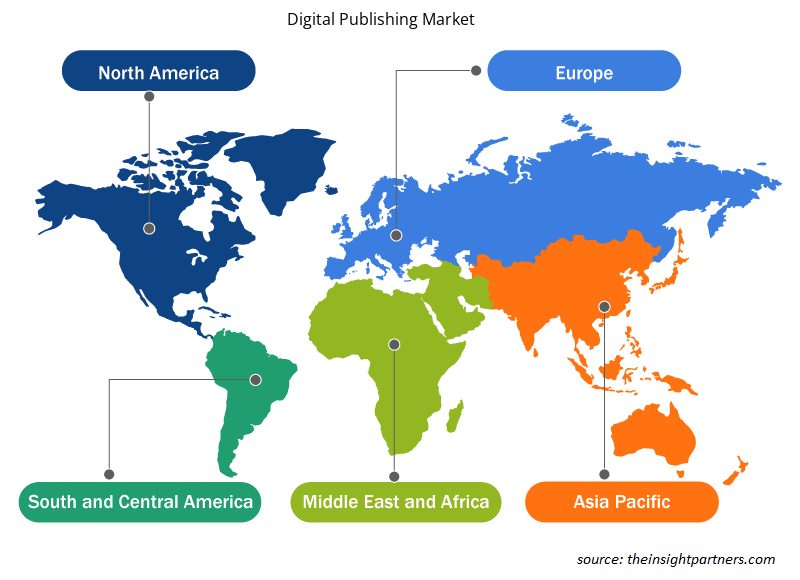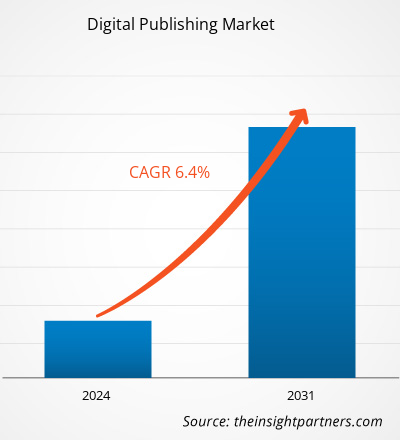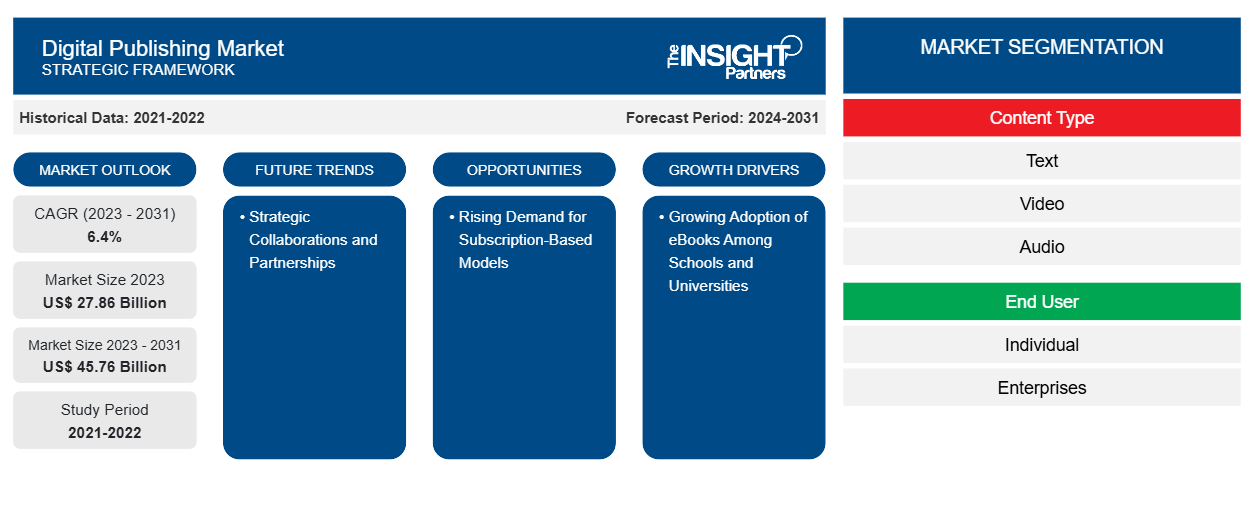预计到 2031 年,数字出版市场规模将从 2023 年的 278.6 亿美元增至 457.6 亿美元。预计 2023-2031 年期间市场复合年增长率将达到 6.4%。战略合作和伙伴关系可能仍是市场的主要趋势。
数字出版市场分析
数字出版正在迅速取代传统的印刷出版方式。此外,COVID-19 疫情以及其他促进数字出版增长的因素也推动了数字媒体的增长。出版商通过选择数字出版,迅速增加了发行量并扩大了当前的收入来源。除了上述因素外,预计未来 6-7 年内,还有几个新的数字出版功能将影响数字出版的增长。例如,产品的文档和实施简单性,以及快速简便地访问的性能和用户体验,推动了对原创内容或用户生成内容的需求,以留住用户、将内容货币化并整合电子商务。
数字出版市场概况
数字出版,又称电子出版或在线出版,涉及传播各种在线内容,如期刊、杂志、报纸和电子书。通过此过程,任何企业或出版实体都可以将纸质文档和数据转换为数字格式,用户可以自行在线访问、下载、编辑、打印或共享这些格式。
定制此报告以满足您的需求
您可以免费定制任何报告,包括本报告的部分内容、国家级分析、Excel 数据包,以及为初创企业和大学提供优惠和折扣
-
获取此报告的关键市场趋势。这个免费样品将包括数据分析,从市场趋势到估计和预测。
数字出版市场的驱动因素和机遇
学校和大学越来越多地采用电子书,市场前景看好
电子书支持教育机构实现三大战略目标:在更具竞争力的环境中提升学生体验和学术成就、促进教学、学习和研究创新,以及帮助优化空间和人力资源的利用。对于大学及其图书馆来说,一个长期存在的问题是如何保证重要书籍的及时供应,学生调查中的主要抱怨往往是书籍数量不足。学生可以随时随地轻松访问电子书,这是一种便捷的选择,可以更高效地满足他们的期望。
此外,教育、培训和探索领域的不断进步正在影响全球数字出版的普及。例如,莱斯特大学通过在线学习提供安全、冲突和国际发展理学硕士学位。犯罪学系提供专门为国际发展领域从业人员或有志于从事该领域的个人量身定制的课程。该课程的学生可以在军事环境、偏远地区或维和部队工作,远离典型的课堂环境。每位学生都会收到一台 iPad,其中包含课程材料、电子书和课程应用程序。即使工作场所缺乏可靠的互联网连接(通常可能无法使用或不可靠),学生也可以访问和阅读这些电子书。教育机构对电子书的使用日益增多,推动了全球数字出版业的扩张。
订阅模式需求不断增长
不断变化的网络环境要求灵活性,这促使出版商实现收入来源多元化。他们正在寻找新的方式来确保财务稳定,超越通常的广告和订阅模式。这种新战略有多种形式:通过赞助内容合作伙伴关系,即品牌共同制作相关内容,或通过联盟营销,即出版商通过营销产品或服务并赚取佣金来赚钱。组织活动或创建在线课程提供了与读者互动的直接方式。它创造了更深厚的联系和更多收入的可能性。出版商正在重新评估他们目前的方法,旨在定制和满足个人用户的需求。微支付正变得越来越流行,它使读者能够为单篇文章支付少量费用,而不是承诺完全订阅服务,从而提供更大的灵活性并满足不同的消费习惯。
数字出版市场报告细分分析
有助于得出数字出版市场分析的关键部分是内容类型和最终用户。
- 根据内容类型,市场分为文本、视频和音频。视频部分在 2023 年占据了相当大的市场份额。
- 从终端用户来看,市场分为个人和企业两类。2023 年,个人市场占据了相当大的市场份额。
数字出版市场份额(按地区)分析
数字出版市场报告的地理范围主要分为北美、亚太、欧洲、中东和非洲、南美和中美五个区域。
预计到 2023 年,北美将占据相当大的数字出版市场份额。该地区对数字出版市场的需求预计将增加,这是由于对改进的数字出版物的需求日益增长。Adobe Inc.、Apple Inc.、Amazon.com Inc.、Alphabet Inc. 等主要市场领导者正在开展合作、收购以及开发新产品和增强功能,从而推动该地区的市场增长。例如,康卡斯特公司于 2021 年 3 月推出了一项新解决方案,用于连接电视的集中广告活动管理。
数字出版市场区域洞察
Insight Partners 的分析师已详尽解释了预测期内影响数字出版市场的区域趋势和因素。本节还讨论了北美、欧洲、亚太地区、中东和非洲以及南美和中美洲的数字出版市场细分和地理位置。

- 获取数字出版市场的区域特定数据
数字出版市场报告范围
| 报告属性 | 细节 |
|---|---|
| 2023 年的市场规模 | 278.6亿美元 |
| 2031 年市场规模 | 457.6亿美元 |
| 全球复合年增长率(2023 - 2031) | 6.4% |
| 史料 | 2021-2022 |
| 预测期 | 2024-2031 |
| 涵盖的领域 |
按内容类型
|
| 覆盖地区和国家 |
北美
|
| 市场领导者和主要公司简介 |
|
数字出版市场参与者密度:了解其对业务动态的影响
数字出版市场正在快速增长,这得益于终端用户需求的不断增长,而这些需求又源于消费者偏好的不断变化、技术进步以及对产品优势的认识不断提高等因素。随着需求的增加,企业正在扩大其产品范围,进行创新以满足消费者的需求,并利用新兴趋势,从而进一步推动市场增长。
市场参与者密度是指在特定市场或行业内运营的企业或公司的分布情况。它表明相对于给定市场空间的规模或总市场价值,有多少竞争对手(市场参与者)存在于该市场空间中。
在数字出版市场运营的主要公司有:
- 好力数码
- 维胡亚
- 维特尔源科技
- 卓越软件技术公司
- Impelsys 公司
- 伊苏
免责声明:上面列出的公司没有按照任何特定顺序排列。

- 了解数字出版市场顶级关键参与者概况
数字出版市场新闻和最新发展
数字出版市场通过收集一手和二手研究后的定性和定量数据进行评估,其中包括重要的公司出版物、协会数据和数据库。以下列出了数字出版市场的一些发展情况:
- FlipHTML5 推出了创新的 AI 电子书创作器,彻底改变了数字出版行业。这款先进的工具简化了电子书创作,使用户能够顺利制作专业的交互式电子书。
(来源:PR UNDERGROUND,新闻稿,2024 年 6 月)
- 为了进一步增强数字出版商和创作者的能力,Ezoic 刚刚推出了备受期待的企业计划。这套全面的服务和功能专为企业级创作者设计,代表着 Ezoic 产品的重大扩展,可提供定制解决方案以满足大型数字出版商和视频创作者的独特需求。
(来源:Ezoic,公司网站,2023 年 3 月)
数字出版市场报告范围和交付成果
“数字出版市场规模和预测(2021-2031)”报告对以下领域进行了详细的市场分析:
- 范围内涵盖的所有主要细分市场在全球、地区和国家层面的数字出版市场规模和预测
- 数字出版市场趋势以及市场动态,如驱动因素、限制因素和关键机遇
- 详细的 PEST/波特五力分析和 SWOT 分析
- 数字出版市场分析涵盖主要市场趋势、全球和区域框架、主要参与者、法规和最新市场发展
- 行业格局和竞争分析,涵盖市场集中度、热图分析、知名参与者以及数字出版市场的最新发展
- 详细的公司简介
- 历史分析(2 年)、基准年、预测(7 年)及复合年增长率
- PEST和SWOT分析
- 市场规模、价值/数量 - 全球、区域、国家
- 行业和竞争格局
- Excel 数据集
近期报告
相关报告
客户评价
购买理由
- 明智的决策
- 了解市场动态
- 竞争分析
- 客户洞察
- 市场预测
- 风险规避
- 战略规划
- 投资论证
- 识别新兴市场
- 优化营销策略
- 提升运营效率
- 顺应监管趋势























 获取免费样品 - 数字出版市场
获取免费样品 - 数字出版市场